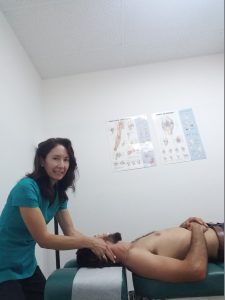
From Dr. Natalie Meiri’s Clinical Pearl Stories:
Chiropractic Care for Pseudotorticollis:
Inability to Move the Head in Any Direction Without Pain
Author: Natalie Meiri, D.C. Posted: 12/17/20
This was a 33 year old patient who presented to my office with neck and mid back pain. To be HIPAA compliant, I will call her Carla instead of her real name. Carla’s pain had come on while preparing her christmas holiday party for 20 people at her house which was in a week. Even though she was excited and happy, this caused her a lot of stress. She didn’t have a history of trauma and couldn’t think of anything she had done. She just “woke up” with this condition a day ago. Carla was particularly concerned since she couldn’t move her head in any direction without pain. Carla had come directly to my office after taking some pain medication which “did nothing”.

Since Carla’s head was held in neutral (posture when the joints are not bent), I thought it was pseudotorticollis and not the classic torticollis where the neck is deviated/twisted in one direction. Pseudotorticollis has no known cause. However, the exam had to be fully performed to rule out any number of causes for classic torticollis. And causes for classic torticollis included CNS (central nervous system) infection, tumor, and basal ganglion (group of neurons/nerve cells in the brain involved in voluntary movement) disease. Above all, Carla didn’t have congenital torticollis (from birth trauma, i.e. breech delivery).
Carla’s consultation and chiropractic care for pseudotorticollis: inability to move the head in any direction without pain
Upon examination, there were positive tests for Carla’s cervical (neck) and thoracic (mid back) spine for pseudotorticollis. She didn’t have a fever with the temperature check (to rule out an infection). Moreover, she had global muscle spasm in her neck. A neurological check for upper motor neuron (nerves that send messages between brain and spine) and lower motor neuron (nerves that relay messages between spine and muscles) dysfunction was negative.
Carla was only 33 years old, but was a smoker for many years which necessitated taking x-rays (to rule out cancer). I took some x-rays of her neck and mid back. Findings on her x-rays were early degenerative joint disease/osteoarthritis (wear and tear type arthritis) of her spine.

Carla’s chiropractic treatment consisted of chiropractic manipulation/ adjustments of the cervical (neck) and thoracic (mid back) spine. Additionally, soft tissue therapy (myofascial release, pressure point and post isometric relaxation to patient tolerance) and modalities (cold/heat therapy and electric muscle stimulation) were administered as needed. Finally, she was given therapeutic exercises to continue her treatment at home.
Carla came in 3 days in a row for treatment the first week. Then 1-2 times a week thereafter for a number of weeks. She was able to host her holiday party feeling much better a week after her initial treatments. Furthermore, she gained full range of motion back in her neck and was pain free at the end of her chiropractic care.
Torticollis and Pseudotorticollis…
Torticollis is an acute or chronic often painful condition characterized by involuntary intermittent or sustained contraction of the muscles of the neck. This causes the head to tilt or turn sideways, bend forward or backward. For instance, these muscles could be the sternocleidomastoid (muscle located at the base of your skull on either side of your neck, behind your ears and goes to the sternum and clavicle) or trapezius (either of a pair of large triangular muscles extending over the back of the neck and shoulders and moving the head and shoulder blade). In Pseudotorticollis (as in Carla’s case), the patient presents with the inability to move the head in any direction without pain.
Torticollis (called also wryneck) may occur secondary to an injury or a preexisting condition (such as a musculoskeletal abnormality or a neurological disease) but is often of unknown cause. In pseudotorticollis, there is no history of injury/trauma and no obvious cause.
Do you know someone in Jupiter, Palm Beach Gardens, West Palm Beach or North Palm Beach who needs chiropractic care for pseudotorticollis: inability to move the head in any direction without pain? Contact Dr. Natalie Meiri of Meiri Chiropractic in West Palm Beach today for chiropractic treatment for pseudotorticollis or another ailment. Call 561-253-8984 to learn more or to schedule an appointment.
Meiri Chiropractic
5601 Corporate Way, Ste 102
West Palm Beach, FL 33407
561-253-8984


